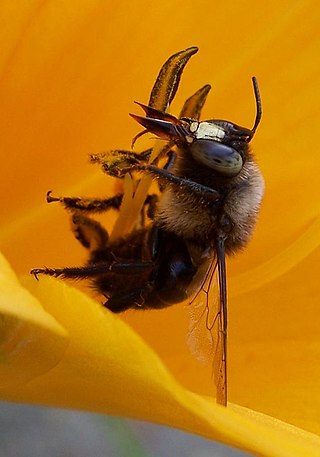
Diadasia is a genus of bees in the family Apidae. Its species are oligolectic, specialized on a relatively small number of plant species.

Calliopsis is a genus of panurgine bees in the family Andrenidae. There are over 80 described species distributed throughout the western hemisphere.

Epeolus is a genus of cuckoo bees in the family Apidae. They are often known as variegated cuckoo-bees. The species is uncommon to rare, and has strong patterns of black and white on the thorax and abdomen. These patterns are made of tiny fat hairs lying flush with the integument or "skin" of the bee. It is easily mistaken for Triepeolus, but is almost always smaller.

Habropoda is a genus of anthophorine bees in the family Apidae. There are at least 50 described species in Habropoda.

Dianthidium is a genus of leafcutter, mason, and resin bees in the family Megachilidae. There are at least 20 described species in Dianthidium.

Svastra is a genus of long-horned bees in the family Apidae. There are at least 20 described species in Svastra.

Eucera fulvitarsis is a species of long-horned bee in the family Apidae. It is found in North America.

Brachymelecta is a genus of cuckoo bees in the family Apidae, formerly known by the name Xeromelecta.

Dieunomia is a genus of sweat bees in the family Halictidae. There are about nine described species in Dieunomia. These bees are relatively uncommon, and are larger than almost every other genus in Halictidae other than Nomia. The wing has two submarginal cells, and the usual bent vein of the basal vein is only weakly present. The male has greatly dilated middle tarsi.

Anthidiellum is a genus of rotund resin bees in the family Megachilidae. There are more than 60 described species in Anthidiellum.

Diadasia australis is a species of chimney bee in the family Apidae. It is found in Central America and North America.

Melissodes communis, the common long-horned bee, is a species of long-horned bee in the family Apidae. It is found in Central America and North America.

Epeolus compactus is a species of cuckoo bee in the family Apidae. It is found in the United States and Mexico. It is a parasite of Colletes kincaidii, with females laying eggs in the host species' nest.

Florilegus is a genus of long-horned bees in the family Apidae. There are about 14 described species in Florilegus.
Nomada crotchii is a species of nomad bee in the family Apidae. It is found in North America.
Xenoglossa kansensis, the Kansas squash bee, is a species of long-horned bee in the family Apidae. It is found in North America.

Panurginus is a genus of bees in the family Andrenidae. There are more than 50 described species in Panurginus.

Xylocopa tabaniformis, the horsefly-like carpenter bee or mountain carpenter bee is a species of carpenter bee in the family Apidae. It is found in Central America, North America, and South America. It is 12–18 millimetres long and black. Males have yellow hair on the thorax.

Nomada affabilis is a species of nomad bee in the family Apidae. It is found in North America.

Svastra obliqua, the sunflower bee, is a species of long-horned bee in the family Apidae. It is found in Central America and North America.


















